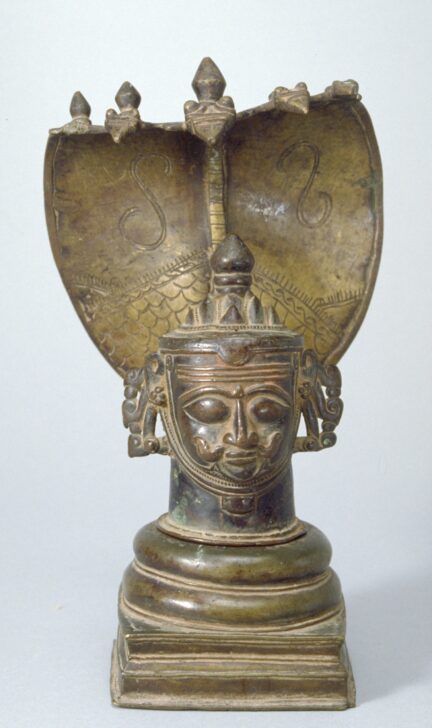Mukha-Linga, Cobra head
Indian

Description
March 28, 2009
The bull, the dog, and the serpent are three of the animals that accompany Shiva and share his nature: they are powerful and can kill; they are associated with the earth, waters, and fecundity; and they are symbols of death and destruction. Snakes, in particular, in shedding their skins, allude to resurrection and rebirth. Like Shiva in his ascetic nature, the snake neither hoards nor builds anything and wanders the mountains and forest underbrush. As such, images of the god are often cloaked in snakes, which wrap around his torso as garlands and rise over his head in the form of elaborate canopies. Here, a five-headed cobra hood rises in a wave from the back of a one-faced Shiva linga. Its concave form functions like a royal parasol, and its position relates it to the halo—two symbols used frequently in Indian art to differentiate and sanctify the space of gods and kings.
(Label for UMMA South and Southeast Asia Gallery Opening Rotation, March 2009)
Subject Matter:
Shiva is often worshipped in his aniconic form of the linga, a representation of the creative power of the phallus. Often the form is quite abstract, being a simple shaft with lines representing a formalized glans penis. But in many cases the shaft is decorated with a face of the god, mukha meaning head and can be seen as eka (one) or sometimes at catur (four) facing the cardinal directions: hence we find ekamukhalingas and caturmukhalingas as well as lingas that are totally plain. A snake hood acting as a canopy over the linga is also very common, adding sanctity to the image. Snake symbolism reflects ancient pre-Hindu religious practice and was absorbed into a number of religions that developed in India.
Physical Description:
This phallic representation of the god Shiva appears as a columnar head placed on a base with two rounded moldings on top of a series of square ones. His neck is fully cylindrical and the face is modeled on that cylinder. The eyes are wide open and a bow shaped eyebrow curves over them. He has a flared nose and luxuriant moustache over a narrow but full lips and a short ball like chin. A ‘U’ shaped element consisting of lines and a pearl motif probably represents his beard, perhaps held up in a tight net. His forehead is decorated with three raise lines that go straight across and his crown is basically flat over his hear decorated with a bunch of peak forms in the center with a finial surmounting the whole. His ears fan out almost like handles to a jar and are decorated with stylized arabesques. A five-headed snake hood rises behind the head and has a rib down its center and scale motives incised towards the bottom an ‘S’ shapes t denote the cobra ‘eyes’ to each side.
Usage Rights:
If you are interested in using an image for a publication, please visit https://umma.umich.edu/request-image/ for more information and to fill out the online Image Rights and Reproductions Request Form.